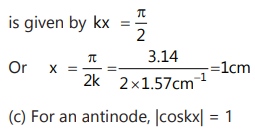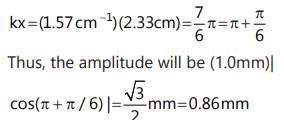Here the two waves of same amplitude and frequency interfere with each other to form the standing waves, the velocity of the resultant wave will be V = ω/K where ω is the angular frequency of the wave and K is the wave number. At the node the waves are 90o opposite in phase, so that the amplitude of resulting wave is zero at the node.
(a) The standing wave is formed by the superposition of the waves

The wave velocity (magnitude) of either of the waves is

The smallest position value of x satisfying this relation

The smallest positive x satisfying this relation is given

(d) The amplitude of vibration of the particle at x is given by |Acoskx|. For the given point,
